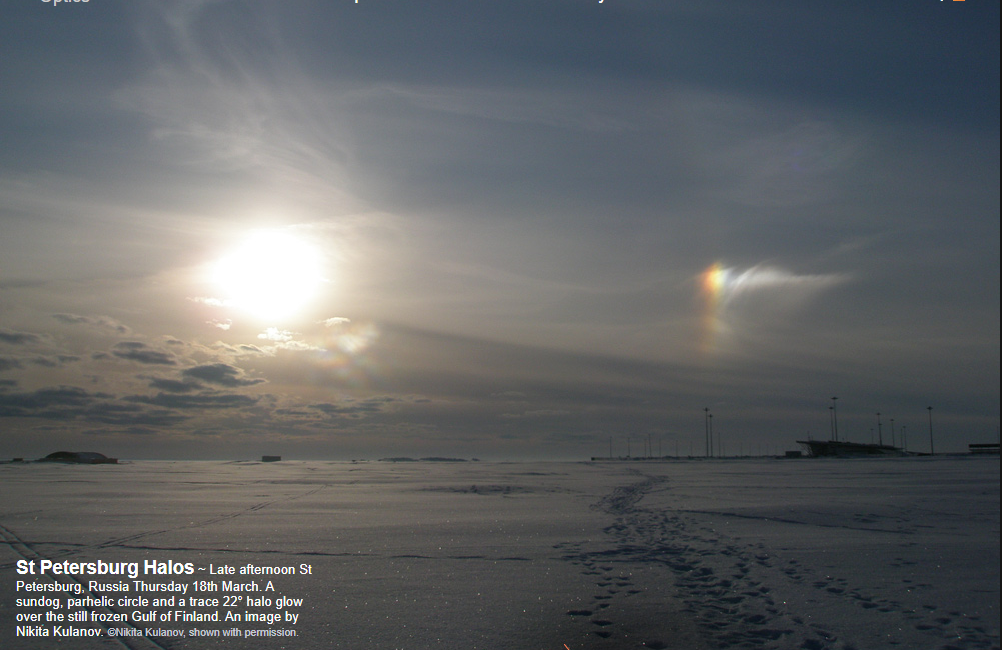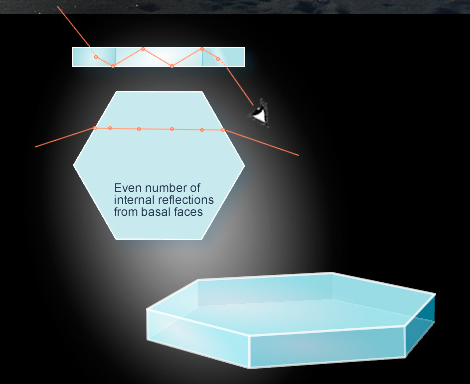St Petersburg Halos
St Petersburg Halos: A Spectacular Atmospheric Phenomenon
St Petersburg, Russia is no stranger to the captivating beauty of atmospheric optics. On Thursday, 18th March, as the late afternoon sun cast its golden rays over the frozen Gulf of Finland, a mesmerizing display unfolded in the sky above. Nikita Kulanov captured this enchanting scene, showcasing a sundog, parhelic circle, and a trace 22° halo glowing in harmony. This rare phenomenon, known as St Petersburg Halos, offers a visual feast for those lucky enough to witness it.
The sundog and the trace of the parhelic circle, visible in the image, owe their existence to the presence of plate-shaped ice crystals. These crystals drift through the air with their large hexagonal (basal) faces almost parallel to the ground. As sunlight passes through these ice crystals, it undergoes a series of intricate interactions that give rise to the stunning halos observed.
Sundogs are typically depicted as rays entering one side face of the crystal and exiting from another inclined at an angle of 60°. However, the reality is more complex. When the sun is not very low on the horizon, the rays enter the crystal at a skew. They then bounce back and forth between the large basal faces, experiencing internal reflections. The proportion of sundog rays undergoing these reflections increases as the sun ascends higher in the sky. Even when the sun is low, a significant number of rays still undergo these internal reflections, creating a captivating spectacle for onlookers.
The Formation of St Petersburg Halos
St Petersburg Halos are formed through a combination of factors, including the orientation and shape of ice crystals, as well as the angle and intensity of sunlight. Here's a closer look at how each element contributes to the formation of this awe-inspiring phenomenon:
-
Plate-Shaped Ice Crystals: The presence of plate-shaped ice crystals is essential for the formation of St Petersburg Halos. These crystals have large, flat hexagonal faces that align themselves parallel to the ground, creating a perfect canvas for the interplay of light.
-
Orientation of Ice Crystals: The orientation of the ice crystals plays a crucial role in determining the specific type of halo observed. In the case of St Petersburg Halos, the plate-shaped crystals align themselves with their basal faces parallel to the ground, resulting in the characteristic sundogs and parhelic circles.
-
Angle of Sunlight: The angle at which sunlight enters the ice crystals is another vital factor. When the sun is low on the horizon, its rays enter the crystals at a skew, causing them to bounce internally between the large basal faces. This internal reflection becomes more pronounced as the sun rises higher, intensifying the halo's brilliance.
-
Intensity of Sunlight: The intensity of sunlight also influences the visibility and vividness of St Petersburg Halos. When sunlight is more intense, it enhances the contrast between the halos and the surrounding sky, creating a striking visual spectacle.
Capturing the Beauty
The image captured by Nikita Kulanov offers a glimpse into the ethereal world of St Petersburg Halos. Through careful composition and timing, Kulanov managed to freeze this extraordinary moment in time, allowing us to marvel at the intricate details of these atmospheric phenomena.
Appreciating Atmospheric Optics
St Petersburg Halos are just one example of the wonders that atmospheric optics has to offer. These natural light displays serve as a reminder of the beauty and complexity of our atmosphere. By understanding the scientific principles behind these phenomena, we can deepen our appreciation for the world around us and find inspiration in the intricate dance between light and matter.
The Magic of St Petersburg
St Petersburg, known for its rich history and cultural heritage, now adds another dimension to its allure with the enchanting St Petersburg Halos. As the city's residents and visitors gaze skyward, they are treated to a visual spectacle that highlights the unique charm of this captivating city.
Exploring the Unseen
While St Petersburg Halos may be a rare occurrence, they remind us of the unseen wonders that surround us every day. The atmosphere holds countless mysteries and surprises, waiting to be discovered by those with a keen eye and a sense of wonder. So, next time you find yourself outside on a crisp winter day or a hazy summer evening, take a moment to look up and see what hidden marvels may be waiting to unfold before your eyes.
In conclusion, St Petersburg Halos are a remarkable atmospheric phenomenon that showcases the interplay between light and ice crystals. The intricate reflections and refractions of sunlight within plate-shaped ice crystals give rise to sundogs, parhelic circles, and halos, creating a captivating display for those fortunate enough to witness it. These phenomena serve as a reminder of the beauty and complexity of our natural world, inviting us to explore and appreciate the unseen wonders that surround us. So, keep your eyes on the sky and let the magic of St Petersburg Halos fill you with awe and wonder.

St Petersburg Halos ~ Late afternoon St Petersburg, Russia Thursday 18th March. A sundog, parhelic circle and a trace 22° halo glow over the still frozen Gulf of Finland. An image by Nikita Kulanov. ©Nikita Kulanov, shown with permission.

The sundog and in this instance probably also the trace of the parhelic circle are formed by plate shaped ice crystals drifting with their large hexagonal (basal) faces nearly horizontal.
Sundog rays are usually shown as entering a side face and leaving from another inclined 60° to the first. It is not always that simple for, unless the sun is very low, the rays enter at a skew. They then internally reflect up and down between the large basal faces. The fraction of sundog rays that are so reflected increases as the sun climbs but even when the sun is low many undergo these reflections.
Note: this article has been automatically converted from the old site and may not appear as intended. You can find the original article here.
Reference Atmospheric Optics
If you use any of the definitions, information, or data presented on Atmospheric Optics, please copy the link or reference below to properly credit us as the reference source. Thank you!
-
<a href="https://atoptics.co.uk/blog/st-petersburg-halos/">St Petersburg Halos</a>
-
"St Petersburg Halos". Atmospheric Optics. Accessed on November 26, 2024. https://atoptics.co.uk/blog/st-petersburg-halos/.
-
"St Petersburg Halos". Atmospheric Optics, https://atoptics.co.uk/blog/st-petersburg-halos/. Accessed 26 November, 2024
-
St Petersburg Halos. Atmospheric Optics. Retrieved from https://atoptics.co.uk/blog/st-petersburg-halos/.